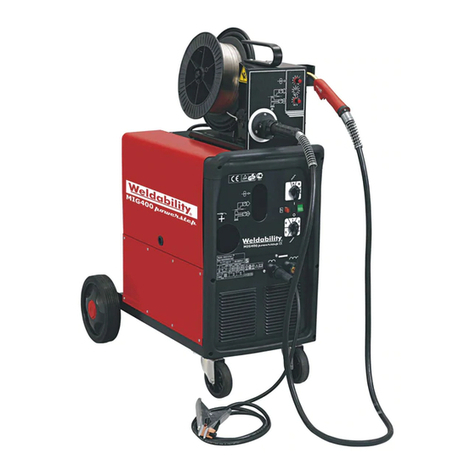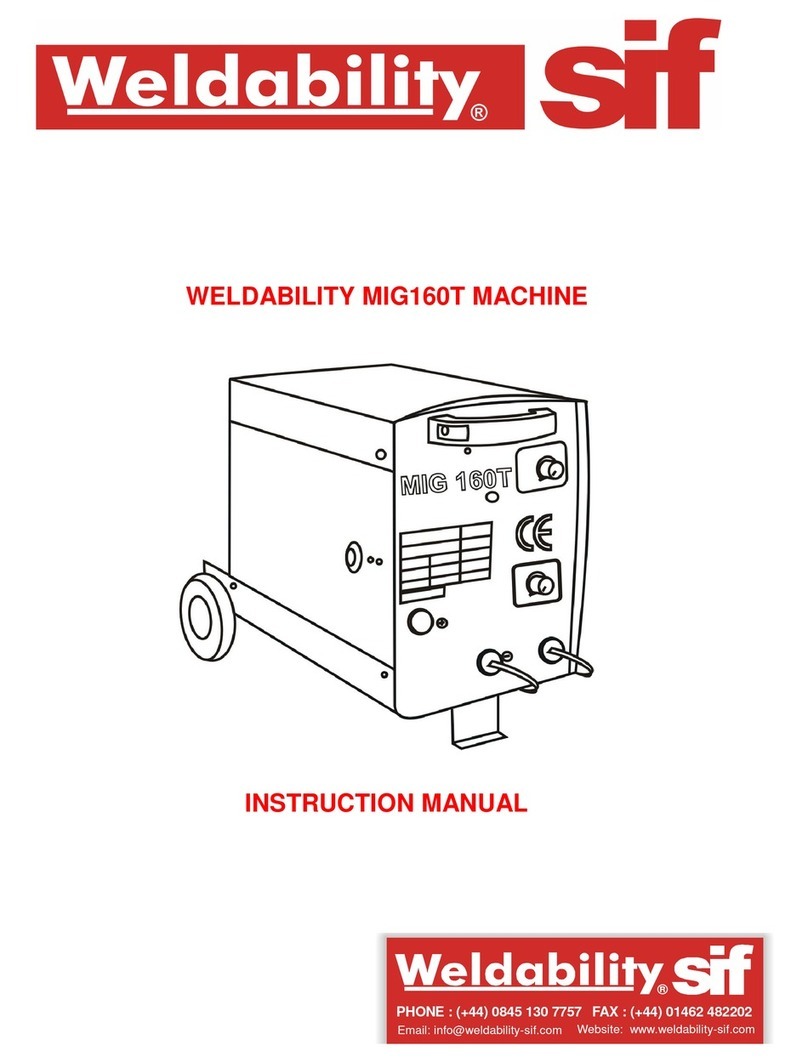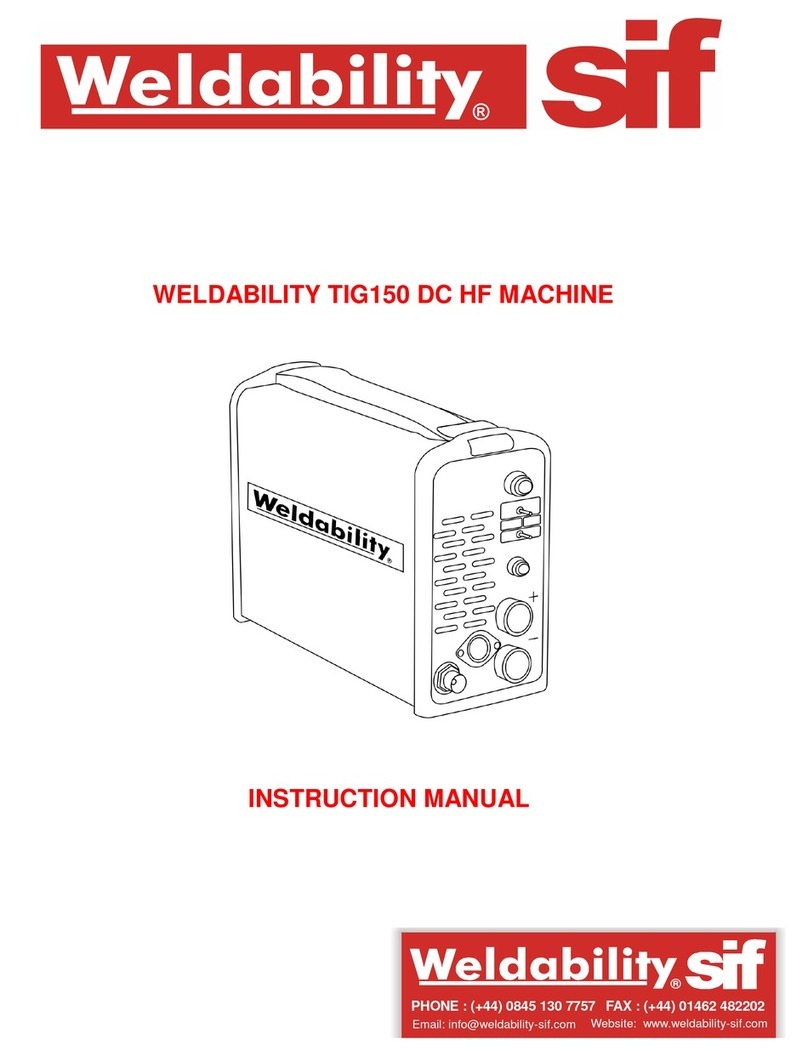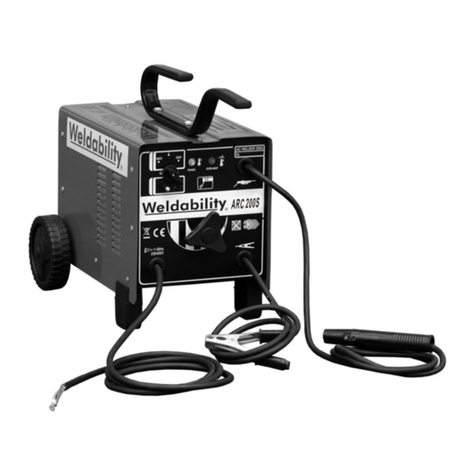
Rubber Hose
Use only hose in good condition, fitted with special
hose connections attached by permanent ferrules. Do
not expose the hose to heat, traffic, slag and sparks
from welding and cutting operations, oil or grease.
Scrap it as soon as it becomes leaky. Good hose will
re-pay the cost many times by long life, safe operation
and elimination of waste through leaks.
Pressure Regulator
Always treat a regulator as a precision instrument. Do
not expose it to knocks, jars or violent pressure caused
by the sudden opening of the cylinder valve. Release
the pressure on the control spring when shutting down.
Never use a regulator on any gas except that for which
it was designed. Do not use regulators with broken
gauges.
Blowpipes/Cutters
For lighting up and extinguishing any type of blowpipe
the maker’s instructions should always be followed. To
clean the nozzle use the manufacturer’s nozzle cleaner
set.
Goggles
Goggles should be worn at all times during welding
and cutting.
ASSEMBLY OF EQUIPMENT
1. Stand both cylinders vertically. Oxygen cylinders
are painted black. Acetylene cylinders are
painted maroon, and Propane cylinders ate
painted red.
2. See that jointing surfaces in cylinder valves and
regulators are FREE FROM OIL AND GREASE.
3. Open the valve on the oxygen cylinder
momentarily in order to snift the cylinder valve,
dislodging dirt or obstructions, then close valve.
4. Open the fuel gas cylinder valve as in item 3.
5. Screw the oxygen regulator into the oxygen
cylinder valve. The cylinder valve and the
regulator inlet stem, and the regulator outlet
connection have a right-hand screwed thread.
6. Screw the fuel gas regulator into the gas cylinder
valve. The cylinder valve, the regulator inlet and
the regulator outlet have left-hand screwed
threads.
7. Tighten the regulator into the cylinder valve. Do
not use excessive force, but make certain that
the joints are gas-tight.
8. Connect the hose to the screwed outlets of the
regulators by means of the screwed connections
secured in the ends of the hose. Blow the hose
through before attaching to regulator or to
blowpipe in order to remove dust or dirt, or chalk
when the hose is new. OXYGEN MUST NOT BE
USED FOR THIS PURPOSE.
9. Connect the other end of the hose, that fitted with
a hose check valve: to the blowpipe, the fuel gas
hose to the left-hand connection, the oxygen
hose to the right-hand connection. Keep the
blowpipe control valves closed.
10. Fit the appropriate sized nozzle to the blowpipe.
To obtain best possible results from Weldability
blowpipes always use Weldability precision
nozzles.
LIGHTING-UP PROCEDURE
Welding Blowpipe.
11. Open the cylinder valves slowly by means of the
cylinder key. Do not open suddenly or there
may be serious damage to the regulator and the
possibility of an accident. Open the cylinder valves
spindle one turn only. Open the fuel gas control valve
on the blowpipe and adjust the regulator to give the
correct working pressure (this ensures that any air or
oxygen is purged from the hose).
Repeat the above procedure for the oxygen side.
12. a. Open the fuel gas control valve and light gas
preferably by means of a Weldability
sparklighter making sure that the sparklighter
is held at right angles to the nozzle.
b. Reduce or increase the acetylene supply to
the blowpipe valve until the flame just ceases
to smoke.
c. Slowly turn on the oxygen by the blowpipe
control valve until the white inner cone in the
flame is sharply defined with the merest trace
of an acetylene haze. The blowpipe is now
correctly adjusted for welding.
Cutting Blowpipe.
a. Proceed with assembly of the equipment
exactly as outlined for the Welding
Equipment, but remember the following
points.
b. After fitting the correct size cutting nozzle,
open the cylinder valves and after purging
both hoses, set the working oxygen pressure
on the regulator with the oxygen passing
through the cutting oxygen valve on the cutter,
hence out through the nozzle. Shut all the
valves on the blowpipe, open the fuel gas
valve slowly and ignite the gas. Open the
heating oxygen valve on the cutter slowly, and
adjust the flame to neutral. Now depress the
cutting oxygen lever and again adjust the
heating gas controls to give a neutral flame.
Depress the cutting oxygen lever, and the
cutter is ready for use. These instructions
apply to the nozzle mix type cutters since
these are of the most modern design.
c. When cutting with a combined welding/
cutting torch, the oxygen valve on the shank
should remain fully open and all adjustments
to the oxygen stream made with the oxygen
valve on the cutting attachment, as detailed in
babove.
CLOSING-DOWN PROCEDURE
13. a. Welding Equipment
Turn off the acetylene first by the blowpipe
control valve and then the oxygen. Close the
cylinder valves. Open the blowpipe valves one
at a time to release the pressure in the hose,
i.e. open the oxygen valve and close it; open
the fuel gas valve and close it. Unscrew the
pressure regulating screws on the oxygen
and acetylene regulators.
b. Cutting Blowpipes
On completion of the work, close the oxygen
cutting valve, then the fuel gas and heating
oxygen valves. Close the cylinder valves,
open and close the cutter, oxygen and fuel
gas valves one at a time to release pressure
in the hose, unscrew the pressure regulating
screws on the oxygen and acetylene
regulators.
14. It is most important to emphasise the earlier
instructions, that prior to re-lighting either the
welding blowpipe or the cutter, the hoses must
be purged to ensure a pure and adequate supply
of oxygen/fuel gas.
Back-fires may occur by one of a combination of
circumstances, e.g. defective equipment, incorrect gas
pressures, incorrect lighting-up procedure or careless
handling of the blowpipe in use, such as permitting the
nozzle to touch the work, overheating the tip of the nozzle, or
working with a loose nozzle.
Usually the back-fire is arrested at the injector in case of low
pressure equipment or the source where the gases are
mixed, e.g. the head of the cutting blowpipe, and if prompt
action is taken in turning off first the oxygen, and then the
fuel gas valve, no damage occurs and the blowpipe may be
re-lit as soon as the cause of the trouble has been
eliminated.
In some cases, however, a back-fire may pass beyond the
torch and go back into either the oxygen or the fuel gas
hoses; it is then termed a ‘flash-back’ and its effect is more
serious in that it may result in immediate damage to hoses
and regulators. In extreme cases there is also a possibility of
injury to the operator. The outward signs of a flash-back may
be a squealing or hissing noise; sparks coming out of the
nozzle; heavy black smoke; or the blowpipe handle may get
hot. If the flame burns back far enough it may even burst
through the hose.
Both blow-backs and flash-backs can be avoided by
adherence to recommended procedure in the case of
equipment. Investigation shows that such occurrences often
occur purely through over-familiarity leading eventually to
neglect of ordinary safeguards. For example, the blowpipe,
on lighting, may have incorrect regulator pressure settings,
or a light being applied before the flow of fuel gas is properly
established.
If the flame snaps out when the blowpipe is in use it is
because:—
a. The regulator pressure and/or gas flow, are incorrect —
they are either too high or too low.
b. The nozzle has been obstructed.
c. The nozzle is held too close to the work.
d. The nozzle has become overheated.
When this happens, completely shut both the blowpipe
valves, check the regulator setting, cylinder pressures, and
re-light in accordance with the procedure. In the case of ‘d’,
close the acetylene valve, reduce oxygen flow to a trickle,
and plunge the nozzle and head into cold water.
Hose Check Valves
The hose check valve is a safeguard which will operate
independently and without attention from the operator. This
device is essentially a non-return valve, the purpose of which
is to prevent back feeding or the reverse flow of gases, it
must in all cases be fitted to the inlet connections of the
blowpipe.
Flash-Back Arrestors
The Weldability flash-back arrestor is a device to be fitted
on the outlet of a regulator or manifold. It contains:
-Non Return Valve (prevents reverse flow of gases)
-Flash-back extinguisher
-Gas shut-off
The non-return valve prevents gas from flowing in the wrong
direction i.e. from torch to the gas source.
The flash-back extinguisher stops and extinguishes a back-
fire in the event of a flash-back.
The gas shut-off interrupts the supply of fresh oxygen and
fuel gas to the torch.
PLEASE ENSURE THESE
INSTRUCTIONS ARE GIVEN TO
THE OPERATOR Ref.: MSDS041
SAFETY PRECAUTIONS AND RECOMMENDED
PROCEDURES FOR WELDING AND CUTTING EQUIPMENT
























